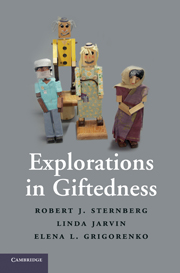Book contents
- Frontmatter
- Contents
- Preface
- 1 What Is Giftedness?
- 2 Theories of Giftedness
- 3 WICS as a Model of Giftedness
- 4 Intelligence and Giftedness
- 5 Creativity and Giftedness
- 6 Wisdom and Giftedness
- 7 Giftedness as Developing Expertise
- 8 Giftedness and Culture
- 9 Learning Disabilities, Giftedness, and Gifted/LD
- 10 Identifying the Gifted
- 11 Educating the Gifted
- References
- Index
9 - Learning Disabilities, Giftedness, and Gifted/LD
Published online by Cambridge University Press: 05 June 2012
- Frontmatter
- Contents
- Preface
- 1 What Is Giftedness?
- 2 Theories of Giftedness
- 3 WICS as a Model of Giftedness
- 4 Intelligence and Giftedness
- 5 Creativity and Giftedness
- 6 Wisdom and Giftedness
- 7 Giftedness as Developing Expertise
- 8 Giftedness and Culture
- 9 Learning Disabilities, Giftedness, and Gifted/LD
- 10 Identifying the Gifted
- 11 Educating the Gifted
- References
- Index
Summary
Ellen is a superb musician but has trouble reading the newspaper. Mario can read the newspaper easily, but has difficulties with even the simplest mathematical problems. Ernest, a marvelous poet, can read and do mathematical computation problems, but he has great difficulty with mathematical reasoning problems. These hypothetical individuals are gifted and yet have a learning disability (LD). To understand the nature of such individuals, sometimes referred to as being “Gifted-LD,” one must understand both the nature of giftedness and the nature of learning disabilities separately, and then in combination (see Newman & Sternberg, 2004).
Various theories characterize gifted children in different ways (Sternberg & Davidson, 1986, 2005). We view giftedness and learning disabilities in terms of excellence in various forms of developing competencies and, ultimately, expertise (Sternberg, 2001a).
The model of developing expertise, described in Chapter 7, has five key elements (although certainly they do not constitute an exhaustive list of elements in the development of expertise): metacognitive skills, learning skills, thinking skills, knowledge, and motivation. Gifted individuals excel in the development of expertise in some combination of these elements, and, at high levels of giftedness, in all of them. Although it is convenient to separate these five elements, they are fully interactive. They influence each other, both directly and indirectly. For example, learning leads to knowledge, but knowledge facilitates further learning.
- Type
- Chapter
- Information
- Explorations in Giftedness , pp. 168 - 176Publisher: Cambridge University PressPrint publication year: 2010

